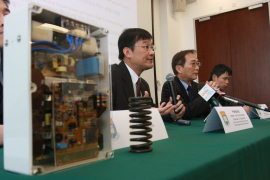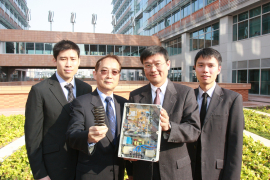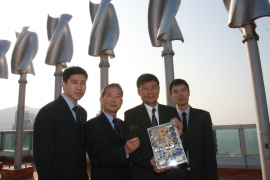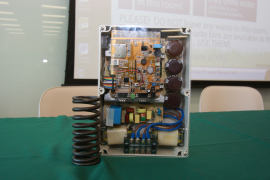Media
Major breakthrough in smart grid technology
by HKU/Imperial College London research team
to provide key solution to future renewable energy power systems
09 Jan 2013
The joint University of Hong Kong /Imperial College London research team has developed a new smart grid technology, the Electric Springs, which is the first in the world and has the potential of providing a key solution to solving the stability problems in future power systems fed with wind and solar power. The invention has been published in the prestigious IEEE Transactions on Smart Grid in late 2012.
Members of the joint research team include Professor Ron Hui, Dr. C.K. Lee, Prof. Felix Wu and Dr. S.C. Tan of the Department of Electrical and Electronic Engineering of HKU; and Dr. Balarko Chauhduri of Imperial College London
A press conference was held today (January 9) by HKU team members to introduce the invention and its future applications.
In the design of future power systems utilizing clean energies, the dynamically changing nature of wind and solar power is expected to cause imbalance between power generation and demand, resulting in instability problems. The Electric Spring technology developed is a new breakthrough that can stabilize future power systems with substantial wind and solar power generation.
Mechanical springs have been commonly used in daily life, such as the suspension systems in vehicles and mechanical support under the mattress. The scientific principle of mechanical springs was described in the 1660’s by the British scientist Sir Robert Hooke (known as the Hooke’s law). Since then, there has not been any development of the mechanical springs in the electrical regime.
The joint HKU/Imperial College London research team has filled this technological gap by developing the world’s first Electric Spring. Electric springs can be embedded in electric appliances such as electric water heaters and then distributed over the power grid. They make it practically feasible for many countries to substantially increase their renewable power generation to a high percentage (say 20% or above). Consequently, renewable power generation can become a major electric power generation component and lots of greenhouse gases can be reduced.
For content of the PowerPoint presentation at the conference, please visit: http://www.cpao.hku.hk/media/es.pdf
For media enquiries, please contact: Ms Trinni Choy (Assistant Director (Media), Communications and Public Affairs Office) tel: 2859 2606 email: pychoy@hku.hk or Ms Melanie Wan (Manager (Media), Communications and Public Affairs Office) tel: 2859 2600 email: melwkwan@hku.hk.




